Features
Kathmandu 1987 and Islamabad 1988
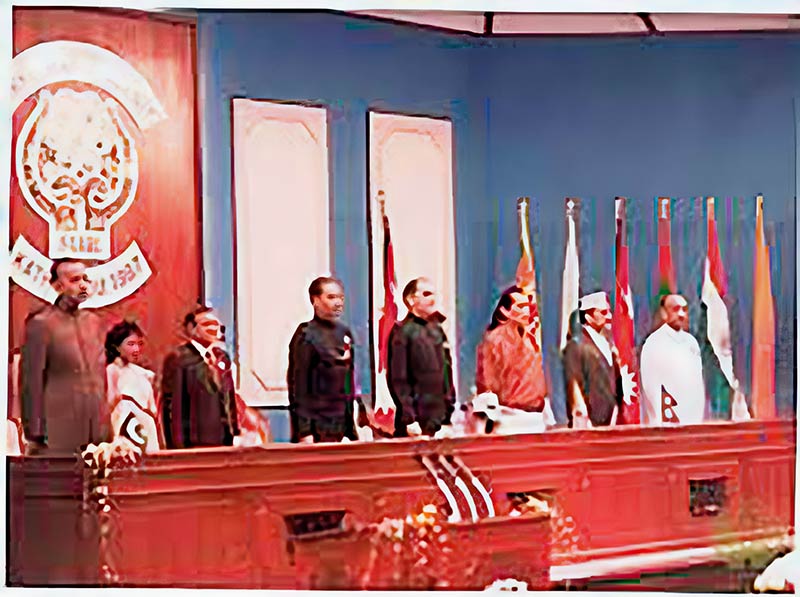
JRJ’s SAARC Summit speeches
(Excerpted from Men And Memories by JR Jayewardene)
At the Third SAARC Summit Meeting in Nepal on November 2-4, 1987, 1 had called for going “full sail ahead” with the King of Nepal in the host’s chair. I said:
“As we all know, regionalism in South Asia has had a late beginning. One of the remarkable developments since the Second World War has been the spread of regionalism, manifested in the setting up of regional organizations which have to cover most of the globe. The fact that SAARC came to be formed so late has been explained by the disparities and imbalances within our region. Nevertheless, there is at the same time, an underlying homogeneity among South Asian countries, on which we hope to build an enduring regionalism for the common benefit of all of us.
“We have to recognize the fact that whether we make a success of SAARC or not, (???) will have to depend on the extent to which we can confront and solve bilateral may have between us. We have also to recognize the fact that our internal problems sometimes have an external dimension, for instance, by causing a spill-over effect in a neighbouring country. And we have furthermore realize that our bilateral problems could have effect on the region as a whole to the detriment of all of us.
“Your Majesty, Sri Lanka’s separatist problem provides a convincing illustration in support of the generalized observations that I have been making. For several years Sri Lanka has been struggling with the problems caused by a group of terrorists who have used the separatist problem to seize power. For several years my government has tried to solve the separatist problem through the good offices of India. In July this year we concluded a Peace Agreement under which India will assist Sri Lanka in settling this separatist problem.
“At the same time, we have established the basis for the conduct of our foreign relations on the principle that nothing would be done by either that could be detrimental to the other in any way. This has to be regarded as an unexceptionable principle, and indeed a prerequisite for good neighbourly relations. The Peace Agreement demonstrates the importance of not confronting each other but of confronting our bilateral problems together. Above all, it demonstrates the importance of our engaging in consultation as frequently as possible.
“We have also demonstrated how we can help each other in times of distress and emergency through the establishment of the South Asian Food Security Reserve, which is a further example of our sense of brotherhood and willingness to help each other. Still we are a long way from resolving our own economic problems. We have not been able to promote trade among countries of our region, and it is ironic that in each of our countries the volume of our trade with other member countries does not exceed five per cent of our trade
“We are meeting under the shadow of the most majestic mountain range on Earth, from where arise mighty flowing rivers into the plains of this great sub-continent giving sustenance and life to the people who live here. Physically we cannot climb higher than Mount Everest which we in front of us. Mentally our minds can soar even higher than these mighty mountains. It can also soar above jealousies, intrigues and the ambitions of man. Even a sunbeam from these heights illuminate us in wisdom and elevate our thoughts towards purity and compassion.
“Mr Chairman, from Dhaka to Bangalore and to Kathmandu, we have come a long way in a relatively short period of time. At Dhaka the SAARC ship set sail; in Bangalore, we found we were away out in the open sea, and here in Kathmandu, I am happy to state that we are firmly on course and proceeding full sail ahead.
At the concluding session of the third SAARC Summit at Kathmandu, I had tried to underline Democracy. Following were my thoughts and words:
“When I came here I knew that Nepal was a part of the area in which Gautama the Buddha was born, lived and preached for over 50 years. He walked all the way from Lumbini to Buddha Gaya, up and down the Gangetic Plain, and passed away at Kusinara, where the Mallas lived. The Mallas are still in Nepal. They lived in the area around the Palace Complex, and their leaders lived in some of the places we visited yesterday.
“The Mallas were democratic people, and so were the Lichchavis who also lived in Nepal till some time ago. During the time of the Buddha they were the republics of the Gangetic Plain. To them, he preached the doctrine of democracy. When they came and asked him; what they were to do if attacked, he replied; “Do your assemblies meet often? Do they follow the rules of procedure? Do they respect their elders? Do they follow the laws of the country?” The reply was “Yes”. Then he said, “Oh, Lichchavis, Mallas, then you cannot be defeated”. That is the message of the Gangetic plain; the message of democracy; the freedom of the people.
The other message he preached was also of love. That is also the message of the Gangetic plain. was this period of history, the sixth century before Christ, that H.G. Wells said, “saw the adolescence of the human race”; when in Greece, Socrates, Aristotle and Plato preached doctrines which saw the birth of European civilization, when humanity there moved away from idol worship and animism to what we now know as modern civilization.
In this period in Persia, Zoroaster preached a similar doctrine. In China, Confucius preached a doctrine still relevant and in India, Gautama the Buddha preached the doctrine of Love, Maithriya, Non-violence and Democracy. I remember another great orator, Surendranath Banerjee from Bengal, when he addressed an assembly of Oxford students in England, before the First World War (1914-1918), and they derided the Indian people, and scoffed at their language, and customs, saying in his reply; “My friends, when your ancestors were swinging by their tails from the trees of your primeval forests, my ancestors had perfected a system of philosophy which is still the wonder of the world, and practiced it”.
When you meet here, when you talk of freedom of the media, of the other matters that have been part of our discussions, when you talk of terrorism and seek to join together to see that violent ways of life can be done away because of man’s ultimate adherence to non-violence, by and large that we can live together. It is because of this adherence to Truth, to Love, to Democracy, that in spite of Empires; in spite of those who believe in violence and nuclear arms, that man is able to survive. So many other species of animals have disappeared. That is the message that SAARC must give not only to our region but at the world.
Islamabad-1988
And at the fourth SAARC Summit at lslamabad in Pakistan December 29-31, 1988–chaired by Prime Miniser Benazir Bhutto I had tried to draw the attention of my distinguish colleagues and those present to our “common heritage”. These were my words:
“On the eve of my relinquishing duties as President of Sri Lanka, a post which I have held for 11 consecutive years, I consider it an honour to be able to participate in this Fourth Summit Meeting of the South Asian Association for Regional Cooperation, for I have been one of those associated with the development of SAARC in its various stages from its inception in 1985.
“Though we are all members of various international organizations, it is SAARC which is our own Association which is dear to us because all of us share a common history and heritage and our political and economic welfare is bound together by our proximity to each other and the geographical necessities that exist in this region.
“South Asia is the home of one-fifth of humanity. Though this region is rich in resources, its people are among the poorest. Our first objective, therefore, as rightly embodied in the Dhaka Charter of 1985, is the promotion of the welfare of the people and improving their quality of life. The alleviation of poverty and malnutrition is our primary task. It seems to me, however, that the various programmes of regional cooperation that we are now implementing will not have an immediate impact in meeting the common challenge facing us. We should therefore re-examine our priorities and our programmes of action to ensure that we do not lose sight of the objectives of our Charter.
“In the past year, our region has seen several natural calamities: floods, cyclones and earthquakes have taken a heavy toll of human lives and caused devastation on a level unprecedented in recent times. When we last met in Kathmandu, we commissioned a study of the causes and the consequences of natural disasters; the protection and reservation of the environment; regional cooperation to strengthen our disaster management capabilities…. gful steps we have taken to assist one
Other in times of calamity is the setting up of the “Food Security Reserve”. This is a notable achievement, but the mechanisms for the action must be sufficiently flexible and effective so that the reserve can be speedily utilized when needed in a time of calamity. We should think of what other measures we can take for immediate assistance. Our Association is young and though we have taken up about 15 areas for regional cooperation, we have still a long way to go. If regional cooperation is to be meaningful and is to have a beneficial effect in improving the quality of life of our people, we must now address ourselves to the feasibility of cooperation in the core areas of trade, industry and economic cooperation.
The members of SAARC, with a market of more than a billion people, could take a lesson from the experience of other associations and take urgent steps to lay the foundation for greater economic cooperation. The time if opportune to set up a Ministerial Committee to examine issues such as the promotion of intra-regional trade, preferential tariffs, joint marketing mechanisms for the export of selected commodities and generally greater economic cooperation among all countries of the region.
For SAARC to become really meaningful and a living reality, our peoples must also get to know each other, and understand and appreciate each other’s culture. It is to achieve this that at this forum we have been stressing the importance of people to people contacts. We can be happy that the areas we have taken up for cooperation such as tourism, exchange of youth, volunteers and academic exchanges are resulting in greater contact between the peoples of our various countries.
Madame Prime Minister, our cooperation is based on the firm belief that the good of all presupposes the good of each. In whatever programmes we undertake, their can be no meaningful cooperation until there is a meeting of the hearts and minds of all the peoples of the region with the stress “the peoples” not only of that of the leaders.
Features
Sri Lankan mannerisms in Ischia, sex in Samoa and Kerala

(Excerpted from Falling Leaves, an autobiographical anthology by LC Arulpragasam)
I became aware of a Sri Lankan mannerism on a two-hour ferryboat to Ischia in 1967. My wife and I were on this ferry on our way from Naples to Ischia, an Italian island just off Capri. We were on one side of the large ferry, while the bar was at the other end, about 20 yards away. Since I was going to get myself a beer, I asked my wife whether she wanted a drink and she indicated ‘Yes’ with her head.
So I crossed the ferry to the bar and ordered the two drinks. The barman, hardly looking up from washing the glasses, asked me briskly: ‘You are from Ceylon, Sir?’ I almost dropped with surprise. First, hardly any Italian knew at that time where Ceylon was, or even that it existed. But secondly, how could he have guessed my nationality just by looking at me? Surprised, I asked him how he could have guessed this so quickly. Smilingly he replied: ‘I saw you asking your wife if she would have a drink, and she shook her head from side to side, signifying ‘No’. But then you came across and ordered a drink for her – which means that she said ‘Yes’. The only place where shaking your head to indicate ‘No’ means ‘Yes’ is in Ceylon!’
I was surprised, first, because I myself had not noticed this seeming ‘contradiction’ before. But secondly, I could not resist asking him how he could possibly have known this. He replied smiling, that he had been a prisoner of war in Ceylon during World War II in the 1940s – and remembered this Ceylonese trait even 25 years later! So Sri Lanka remains the country, where we shake our heads, understood elsewhere to signify ‘No’, when we actually mean ‘Yes’!
As a matter of interest, the barman also told me that the happiest years of his life were spent ‘in prison’ in Ceylon, roaming the hills of Diyatalawa where the Italian prisoners were supposed to be confined! The British must have been confident that their prisoners would not escape from their haven (heaven) to go back to war-torn Europe!
‘Sigñora, your Midriff is Showing’
In Italy today, women at the age of 50 are usually slim, elegant, well-groomed and sexy. This was not the case in Italy in the 1960’s when women over 50 (especially in the south) often had a ‘pasta roll’ around their waist, usually dressed in black dresses and black stockings, as a sign of mourning for some long-departed member of the family. My wife, on the other hand, usually dressed in her full sari with a choli blouse, which coyly showed a bit of midriff.
When visiting a supermarket, this was the cause of some consternation among two elderly Italian ladies, modestly dressed in baggy black gowns. After talking agitatedly among themselves, one of the ladies, not being able to contain herself any longer, came across to my wife and said: ‘Pardon me, Sigñora, but your midriff is showing’ (in Italian: ‘nuda’, meaning ‘nude’). My wife taken aback and nonplussed, looked down at her midriff and asked in surprise: ‘What’s wrong with my midriff?’ The old lady, even more agitated, replied that it was ‘nuda’.
At this point my wife looked at the old lady’s legs and said ‘Sigñora, but your legs are showing’. (In South Asia at that time, it was considered immodest for a woman, especially an older woman, to show her legs: but this was obviously not so in western society). The old lady, equally taken aback, looked down at her legs and said: ‘What’s wrong with my legs?’ And my wife replied: ‘They are nuda’. The old lady was puzzled. Not knowing what to make of this weird exchange, she walked back to her companion for more animated discussion! We were amused at this cross-cultural exchange: of two cultures speaking across each other, but not to each other, in terms that neither could understand.
It is equally interesting to note changes within the same culture over time. On a typical Italian or western street today, in the year 2014, girls walk around with whole midriffs exposed, showing also their belly buttons, suitably embellished with rings, while their ‘hipsters’ are worn so low that they are in danger of falling off altogether! I wonder what the Italian old ladies would say to this now!
Along the same lines, the exposure of female legs is either a matter of good taste, sexiness or shame, depending on the culture or country concerned. In the Indian sub-continent (including Nepal, India, Pakistan, Bangladesh and Sri Lanka) it is not decent for women to expose their legs, least of all above the knee, although it is customary, fashionable and sexy in the western world to do so. Going farther afield, in China, one notes that legs were not considered sexy at all – nor a matter of pride, shame or sexiness.
Traditionally in China (before Mao’s time) women wore the cheongsam, a long dress with a slit all the way up the thigh. On the other hand, these same Chinese women in those days were embarrassed to show their necks, favoring high collars so that their necks would not be exposed! This is in contrast to women in the Indian sub-continent, who have no problem in showing their necks but do have problems in showing their thighs!
Sex in Samoa
Growing up in colonial Ceylon, I was shocked to the depths of my prudish soul to read Margaret Mead’s ‘Coming of Age in Samoa’. (I know that her findings have subsequently been challenged by Dr. Derek Freeman; but since the final verdict is not in, I shall treat her observations as valid for purposes of this article). When I was personally able to visit the Pacific islands in the 1970s, instead of free sex, the girls after colonization and Christianization, now wear grass skirts over their jeans and only sing hymns to hula music!
According to Margaret Mead, young boys and girls in Samoa in the 1920s, ranged around in groups, swimming together and having fun and sex together. Teenage girls slept with many boys and even had children by them. More interesting to me (later) was how the social, moral and family organization accepted these activities and absorbed their consequences. First, in the Samoan context at that time, it was not shameful or sinful for boys and girls to have sex before marriage – even at the age of fourteen or fifteen. Secondly, if a girl of that age were to give birth to a child, this was quite normal, and not a matter of shame. Hence, thirdly, this was not a bar to the future marriage of the girl, since a man would marry her especially because she had already proved that she could bear children, which was important for his future family.
Fourthly, there was no question of the child being ostracized or abandoned, because it would be gladly taken into the extended family or kin group, since an extra pair of working hands was an asset rather than a liability. Fifthly, these arrangements allowed a woman to have sex throughout her entire child-bearing period, starting at puberty and lasting till she no longer wanted sex. When I read Margaret Mead in later years, what impressed me most was how these arrangements relating to sex and the family had been so rationally organized (internally consistent) within the Polynesian society from a biological, social and economic point of view.
The same can be said of the Nayar community in Kerala, India, in the late 19th and early 20th centuries. The facts as I know them are recounted only to illustrate a different set of such arrangements. The Nayar community in Kerala was at that time a strongly matriarchal and matrilineal society. It was agrarian-based, with property passing from mother to daughter along the female line, such that a son did not inherit property. This brought about not only an interesting arrangement of sexual ethics but also concomitant arrangements regarding marriage, the family, and the distribution of labor, income and property.
The main economic and social activity at that time centered round the cultivation of land. Since the woman in the family owned the land, she made all the decisions relating to its disposition and cultivation. She also made the family decisions in the household, including the choice of who would work for her and who would sleep with her. As for daily or nightly arrangements, the chosen ‘husband’ for the night would leave his garment and slippers outside her door, so that others could see that she was otherwise engaged for that night.
Since the children from this arrangement were known as the mother’s children, the identity of the actual biological father ceased to be of importance. The fathers of the children were all ‘uncles’, who continued to live and work in the household and were supported by it in their old age. The resulting children were looked after by the family/household. Under this arrangement, the land (the economic base) was cultivated, while social and economic security was ensured for members of the extended household. Here again, sexual arrangements seem to be in harmony with biological, family, social and economic needs and organization. Needless to say, these arrangements are not more ‘moral’ or ‘immoral’ than those in western societies today – only different, and also more internally consistent.
When Margaret Mead wrote of teenage sex in Samoa in the 1920s, the western world reacted with moral outrage at the immorality, licentiousness and sinfulness of it all. This was a time in the west when sex before marriage was a sin and when children born out of wedlock were ostracized by law and custom. However, today in the west, teenage sex seems to be more the norm than the exception, with surveys showing that over 40 per cent of teenagers have had sex before they leave high school.
While this was still considered socially shameful and morally reprehensible in the year 2000, the social scene is moving so fast that already by 2013, unwed single women are planning to get pregnant outside wedlock. Today in the western world, there is sex among teens, sex before marriage, couples living together without marriage, sex outside marriage, and multiple divorces. Sounds familiar? Exactly! In less than 70 years, western society, the dominant culture today, has gone back (regressed?) or advanced (progressed?) to equate to the sexual practices of Samoa in the 1930s! Thereby hangs a cautionary tale!
Features
Return to Normalcy: After Rajapaksa Kakistocracy and Supercilious Ranilocracy
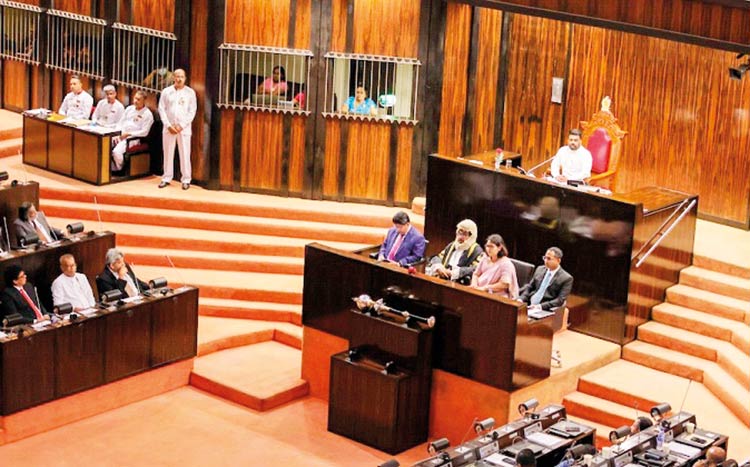
by Rajan Philips
A word first used in 17th century England is gaining new currency in 21st century America. Kakistocracy, a Greek derivative per usual, means government administered by the worst group of citizens – in qualification, competence, experience and scruples. Kakistocracy is in full display in the US with the election of Donald Trump as president for a second term. America is returning to chaos not heeding Kamala Harris’s warning against going back.
In Sri Lanka, Rajapaksas epitomized Kakistocracy for nearly two decades before it imploded under Gotabaya Rajapaksa. After them came Ranil Wickremesinghe to clean up the economic mess left behind by the Rajapaksas. To his credit, Mr. Wickremesinghe did clean up the economic mess. But he also created a political mess, characteristically and superciliously
The mess that Ranil made, heaped atop the mess that has been piling up for all the years of this century finally became insurmountable for the entire political establishment comprising the UNP, the SLFP, and their offshoots, the SJB and the SLPP. They have been sent packing by the people, unsung, unwept and unhonoured. There is an SJB rump but without a winning leader.
Sri Lankans have turned the page and opened a new chapter. There is a new president, a new parliament and a new cabinet. There is both the return to old normalcy, as well as the beginning of a new normal. The end cannot be taken for granted, but there could not have been a better start for the making of a new nation.
Politics is nothing but constant work in progress. No government can deliver on everything that is possible. The best any government can do is to maximize the good that is possible and minimize the bad that is avoidable. And achieve within its term durable benefits for the people. There is enough reason to be optimistic about the new government while being alert to the risks – that are also aplenty – of its straying off course.
There is already an indication of straying in the elephantine omission of any reference to the future of the executive presidency or the enactment of a new constitution in an otherwise well crafted and comprehensive inaugural Policy Statement by President Anura Kumara Dissanayake at the opening sitting of the new parliament on Thursday.
I read the English version of the speech issued by the President’s Media Division, and even ran the ‘word find’, looking for words like – constitution, executive, president, referendum – and found none of them, let alone abolition! There is one reference to ‘provincial councils’ but that is also in connection with the role they could play in ‘cleaning Sri Lanka’. There is also no mention if and when local government and provincial council elections will be held. I don’t think these omissions are a result of translation from Sinhala to English.
And they will be viewed as grave omissions by NPP critics considering the pillorying that was given to Ranil Wickremesinghe over elections and their postponements. Already there have been criticisms over the government’s walking back on the promise to repeal the Prevention of Terrorism Act. At least the government issued a statement indicating its position on the PTA matter.
But omitting any reference to a new constitution or the executive presidency in the Policy Statement flies in the face of the government’s insistence on being transparent and accountable. NPP’s many critics will justifiably view this omission as a sign that the new government is not going be any different from its predecessors in making and breaking promises to abolish the executive presidency. Unless the government has other plans, and we are not privy to it. Otherwise, this will be a part of the old normal.
The omission is also unfortunate in that it diminishes the government’s impressive achievements in setting up its first cabinet and in outlining its policy framework in the President’s well thought out statement to parliament. The new president, parliament, the new cabinet and the President’s Policy Statement are also indicative of the sociology of the JVP’s metamorphosis into NPP and the roots of their political success.
A New Beginning
It could easily be said that the NPP cabinet is the most compact and competent cabinet of ministers to be assembled in Sri Lanka in the 21st century. Unlike other presidents this century, President AKD has restricted his portfolios to three: Defence, Finance and Planning & Digital Economy. This is more in line with President JRJ’s portfolios that closely resembled the Prime Minister’s portfolios during the parliamentary system of government. This is moving away from the practice of presidents assigning themselves too many portfolios that began with President Kumaratunga.
However, in keeping Finance under his wings, the President is continuing the practice that was also started by President Kumaratunga in 1994. Finance deserves to be a single portfolio of a single cabinet minister without any other occupational distractions. That is why Professor Mick Moore, who called Sri Lanka’s economic crisis under Gotabaya Rajapaksa, “a man-made problem”, subsequently advocated that Sri Lanka should get back to the old-style finance minister carrying only the finance portfolio.
The identification of portfolios and the selection of individual ministers would appear to be based on considerations of ability, political and/or professional experience, and electoral results. Nine of the cabinet ministers led the vote tallies in their respective electoral districts, and include mostly old JVPers and new NPPers. Seven of the ministers are those who came second or third in their electoral districts. The elected MPs in the cabinet reflect the JVP/NPP’s geographical sweep and its sociopolitical roots in the electoral districts in seven of the island’s nine provinces.
Six of the cabinet ministers are drawn from the NPP’s 18 National List MPs, which is a high proportion that indicates the need for balancing electoral representation with cabinet competence. Two of the National List cabinet ministers, Bimal Ratnayake and Ramalingam Chandrasekar have been credited for their political work in the Jaffna District that led to the NPP’s electoral success in the district. Mr. Ratnayake is a seasoned JVP parliamentarian, while Mr. Chandrasekar is a new MP and also the Minister of Fisheries and Aquatic & Oceanic Resources.
Chandrasekar with Saroja Paulraj, who was elected from Matara and is the new Minister of Women’s and Children’s Affairs, are both from the Malayaha Tamil community. The two ministers seem to be part of a new turn in cabinet making that privileges not ethnic representation but political participation. That would be consistent with the vision of an equal, inclusive and ‘non-racial’ Sri Lankan society that President Dissanayake eloquently articulated in his Policy Statement. But until that Eldorado is reached the government has to deal with misgivings about missing Muslim and Sri Lankan Tamil representation in the cabinet.
Features
The Need to submit an electronic tax return and its challenges

By Sanjeewa Jayaweera
The Inland Revenue Department (IRD) has decided that compliant taxpayers who submit their Return of Income for 2023-24 (01 April 2023 to 31 March 2024) can only do so electronically by submitting an e-return.
Whilst it is undoubtedly a step in the right direction, no consideration has been given to the fact that such a move should be made in a phased manner. In typically cavalier fashion, the department’s mandarins want to go from zero to a hundred, forgetting that many individual taxpayers have no experience submitting tax returns, let alone e-returns. I assume many new taxpayers who have not previously submitted tax returns annually have been inducted into the tax net.
Even if an individual has registered as a taxpayer voluntarily with the IRD or where the IRD has on their own allocated a tax identification number (TIN) based on information available to them, the taxpayer still needs to request a Personal Identification Number (PIN) to be issued to access the IRD eService at their website to submit an e-return. The PIN can be received by email or by post. If you elect to receive the PIN by email, a separate process must be followed to register your email address with the IRD. If you elect to receive the PIN by post, this can take several days. Some taxpayers who were unaware that submitting an e-return was compulsory did not have the luxury of time on their side to receive the PIN by post.
The IRD had forgotten that many senior citizens either don’t have a computer at home or are not computer savvy enough to navigate the e-return. In addition, there are supporting documents to be uploaded, which require a scanner or going to an external party to get the documents scanned, which is not ideal as most documents are personal and confidential.
Due to several complaints by senior citizens (over 60 years), the IRD has finally agreed to accept a manual tax return if the taxpayer is willing to give a written declaration as to why they cannot submit an e-return.
Entering AIT details to the e-return and non-standardization of AIT certificates
Once you have managed to access your account, the frustration starts. For some strange reason, when disclosing income from fixed deposits, the IRD wants many columns of information ranging from the name of the bank, the bank TIN, the gross interest, the amount of advance income tax (AIT) deducted, the date when the bank had paid over the AIT deducted to the IRD, the certificate number that the bank had issued to you and so forth. You need to enter twelve rows of information if you have a fixed deposit where interest is paid monthly. If you have ten fixed deposits generating monthly interest, you must enter 120 rows of information! It is insane.
Your frustration is further accentuated when you realize that the bank has not given all the necessary information in the certificate issued that the IRD wants from you. This is an utterly unacceptable state of affairs as the IRD should have agreed with the banks as to the format of the AIT certificate to be issued to the customers. I assume that this has not been done because most of the banks are not issuing AIT certificates that comply with the requirements of the IRD. While appreciating that banks face a challenge in modifying their computer-generated reports, they must prioritize this aspect to support the government’s drive to collect taxes and induct non-compliant taxpayers into the tax net. This is an area in which the banks must play an important role.
Banks should compulsorily obtain customer TIN and their excessive charges
As an initial but essential step, the banks must, in my opinion, request all their customers who have fixed deposits to provide their Tax Identification Number (TIN). This is mandatory in several other countries. Once the customer’s TIN is known, the bank can submit their monthly computer returns to the IRD, including the TIN, enabling the IRD to upload the taxpayer’s interest income and AIT deducted as pre-filled information to your tax return. The IRD has attempted to do so but has miserably failed in their attempt as, presumably, the returns submitted by the banks did not have the necessary information.
Another concern is when banks charge customers excessive amounts as bank charges to issue a confirmation of their deposits and bank balances as of 31st March. This certificate is necessary to support your declaration of assets in the tax return. Some banks charge as much as Rs. 750 to confirm a balance. The charge is basically for a printout from their computer system of your money they hold!
The need to settle Income Tax by Online Transfer or by Bank Pay Order
Another inconvenient and inconsiderate move by the IRD impacting individual taxpayers during the year was to introduce a rule requiring that income payments be made to the IRD only by online transfer or by a bank pay order. The initiative is undoubtedly due to a high incidence of dishonoured cheques. However, in my view, the IRD should allow individual taxpayers whose payments are less than Rs. 5 million for a quarter to pay by personal cheque. This would no doubt again help senior citizens who either don’t have online banking facilities or are reluctant to make electronic transfers.
The IRD must be sensible and considerate of individual taxpayers in making these decisions. I also find the rule applied only to income tax payments rather strange, as the IRD’s revenue from value-added tax is more or less the same as income tax, but there is no mandatory requirement to pay VAT by online transfer or bank pay order. Therefore, it is rather difficult to comprehend the IRD’s thinking in this.
I hope that by the time the next income return for 2024-25 is due in November 2025, the IRD and the banks will have resolved many of the issues I have highlighted. Citizens must be tax compliant and pay their taxes; however, the IRD must also make the process a bit simpler for individual taxpayers.
-

 Sports3 days ago
Sports3 days agoPathum will become world’s best batter, says Jayasuriya
-
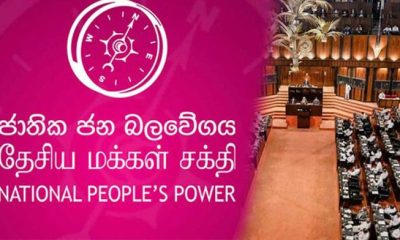
 News7 days ago
News7 days agoNPP appoints two defeated candidates as NL MPs
-
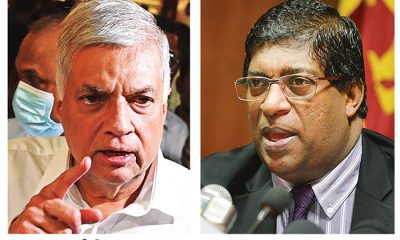
 News6 days ago
News6 days ago‘Gas Cylinder’ explodes; Ranil flays NDF Secy. for submitting Ravi’s name
-

 Midweek Review5 days ago
Midweek Review5 days ago‘Ramayanizing’ Sri Lanka by Courtesy of SriLankan Airlines
-
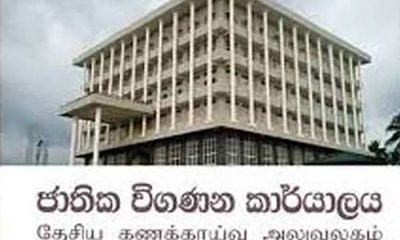
 News2 days ago
News2 days agoAbout 1,000 permits issued to SL migrant workers for electric vehicle imports misused
-

 Sports6 days ago
Sports6 days agoMaking batting compulsory for bowlers has worked – Theekshana
-

 Sports4 days ago
Sports4 days agoSri Lanka’s cricket revival continues
-
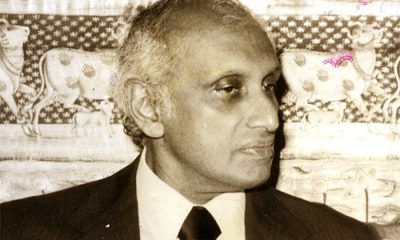
 Features5 days ago
Features5 days agoShould we go back to build another Southern Order?











